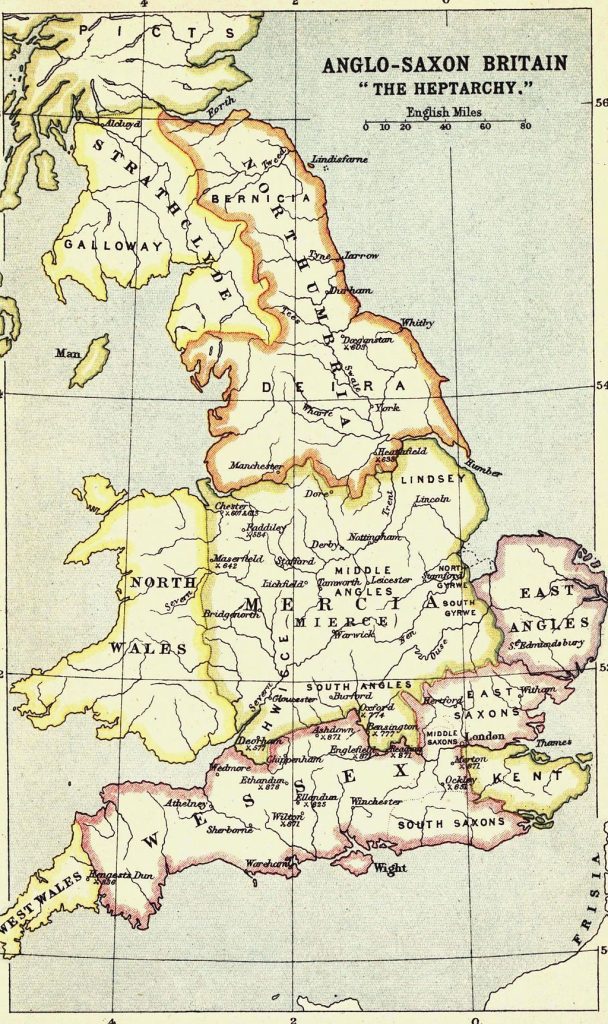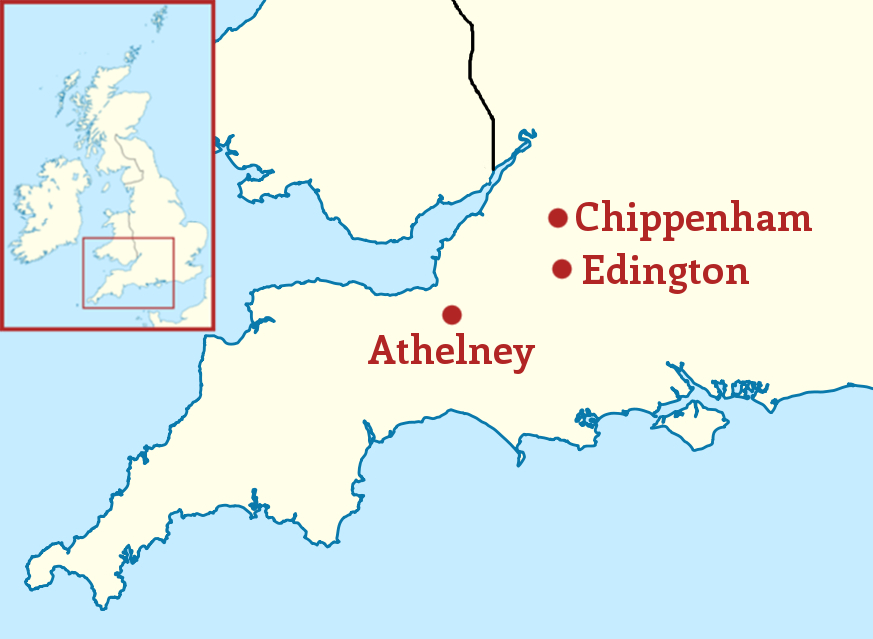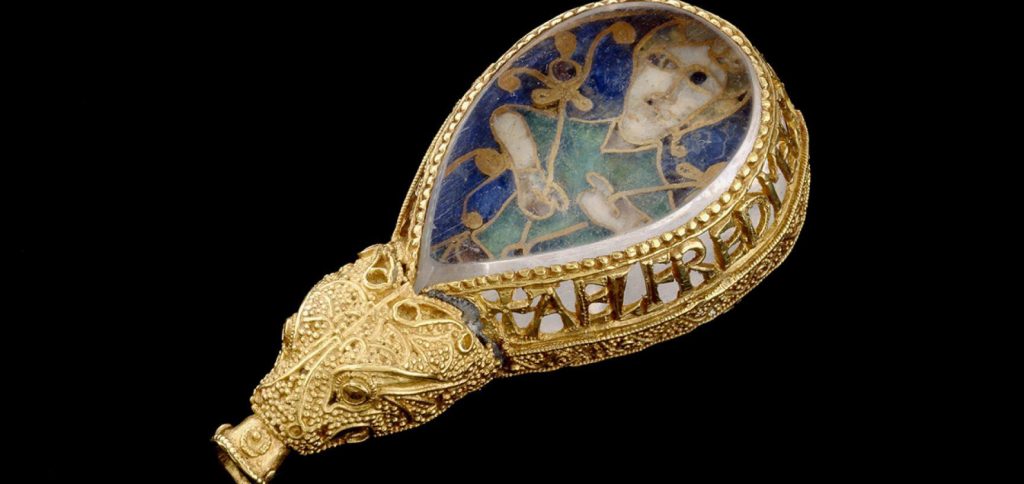Our place in history
The story so far. We have seen evidence of Neolithic and Roman activity in the parish of Nettleton. Here we take a look at the early medieval period, and of the presence of Saxons and Vikings in Wiltshire.
Tyranny in the wake of Roman exit
Following the Roman withdrawal from its province of Britannia, the country descended into anarchy. The island of the Britons was made up of many territories led by warlords (tyranni) battling each other for power.
These territories may have been based on the Roman model of citizenship known as civitates (from which the words civil, civic and city derive). In any event, it was to these civitates that Honorius (411 AD) addressed his rescript (a Roman emperor’s written reply to an appeal for guidance) that the Britons must henceforth look to their own defence.
All this infighting left the Britons open to incursions from overseas. The incomers were of diverse origin: Danes, Angles, Saxons, Jutes, Huns, Friesians and more. They came to trade, settle, and for the better farming conditions than those prevailing in northern Europe. Nevertheless, they also came to raid and conquer.
Rather than a mass invasion, however, it is thought that over the course of the next two centuries incomers achieved a position of political and social dominance, aided by intermarriage. This initiated a process of acculturation of Britons to the incoming language.
The new leaders established and consolidated their rule by reference to, or the creation of, origin myths.
Saxon Heptarchy

From the fifth century, several petty-kingdoms emerged, often contending for supremacy. For the purposes of our story, we focus on the kingdom of West Saxon.
Wessex
The West Saxon kingdom, known as Wessex arose in 519. However, Northwest and West modern Wiltshire appear to have remained in British hands for some hundred years or more when the Saxon invasion was completed.
Specifically, the area from Kemble in the North to Bath in the South, and from the Bristol Channel in the West to Oldbury in the East, appears to have been a single territory in British hands until the 7th century. The whole area – including what is now Burton – may have lain within the former civetas Dubunnorum. The names Kemble, Minety and Keevil may refer to their position on a boundary, the names being of British origin.
In 825, Ecgberht (alt. spellings: Egbert, Ecgbert, Ecgbriht, Ecgbeorht or Ecbert) of Wessex and Beornwulf of Mercia met at The Battle of Ellendun in Wiltshire. Beornwulf’s defeat effectively ended Mercian rule over the southern kingdoms and established West Saxon dominance in southern England.
On Ecgberht’s death in 839, the kingdom passed to his son Æthelwulf, whose sons, Æthelbald, Æthelberht, Æthelred and Ælfred (Alfred), each in turn inherited Wessex.
The Vikings
In 865, during Æthelred’s reign, a combined Danish force of what became known as the Great Heathen Army landed in Northumbria and East Anglia. Six years later, reinforcements arrived from Scandinavia (the Great Summer Army). The allied army invaded Wessex. Although Æthelred, supported by his brother Alfred, won some victories, they also suffered several defeats and heavy losses of men, compelling Alfred to pay the Danes to leave Wessex.
In 871 and aged only 21, Alfred succeeded his brother to the kingdom of Wessex.
Over the next few years, the Vikings led by Guthrum made several more attempts to vanquish Wessex, but were beaten back each time.

Then, just after Twelfth Night 878, Guthrum launched a surprise attack on Alfred at his royal estate in Chippenham. Alfred only had his personal guard in attendance. A rout ensued. Alfred was forced to flee to the safety of the Somerset marshes while the Vikings began to swarm across Wessex.
All seemed lost for Alfred, in hiding and dependent on local people for food and shelter. He even burnt the cakes! However, despite everything, Alfred was able to establish himself at Athelney, a small island in the marshes. From this base he gathered a force and led them in an attack on Guthrum and his army at Edington in May 878. The battle was bloody, but Alfred was victorious.
So marked the Vikings’ final withdrawal from Wessex.
English Unification
The decline of the Heptarchy and the eventual emergence of the kingdom of England was a drawn-out process, taking place over the course of the 9th to 10th centuries. In the 9th century, the Danish enclave at York expanded into the Danelaw, with about half of England under Danish rule. English unification under Alfred the Great was a reaction to the threat from this common enemy. In 886, Alfred retook London, and the Anglo-Saxon Chronicle says that “all of the English people (all Angelcyn) not subject to the Danes submitted themselves to King Alfred.”

The unification of the kingdom of England was complete only in the 10th century, following the expulsion of Eric Bloodaxe as king of Northumbria. Æthelstan is credited as the first to be King of all England.
For more on this period in our history, see here.
For more on our history generally, see here.
If you are interested in origin myths of Britain read Storyland: a new mythology of Britain (2022) by Amy Jeffs
Bibliography
Eagles, Bruce (2001) ‘Anglo-Saxon presence in Wiltshire c. AD 450-c. 675’, in Roman Wiltshire and After: Papers in Honour of Ken Annable, ed. P.D.Ellis (Wiltshire Archaeological Society, 2001)
Chippenham Town Council (2021) The Story of Twelfth Night 878AD



9 Comments
Ian Wilson · 03/29/2023 at 7:33 am
What is the story of Slaughterford? I have never researched it but understood a Viking army was routed there. Is this so or just hearsay?
Amanda Read · 03/29/2023 at 10:43 am
Thanks for the question, Ian. Funnily enough, I came across the answer during my research. I believe I found it in Gover’s Place names of Wiltshire, but I’ve already handed back the batch of research literature to the library. The answer is less bloody, but in keeping with the rural nature of the area. Slaughterford is thought to mean ‘ford where the sloes (blackthorn) grow’.
Amanda Read · 03/29/2023 at 11:39 am
A bit more on the Slaughterford name question. In The Wiltshire Cotswolds (Watts, 2007) pp.158-9, John Aubrey is cited as claiming that near Ford ‘St Oswald was slain by Panda [of Mercia] on the great down at Marshfield’. Watts goes on to say that Oswald was the king of Northumbria and that according to the Anglo Saxon Chronicle he was killed at Maserfeld that is generally said to be Oswestry – so Wiltshire is bit out of his way. Watts goes on to suggest that Aubrey’s ‘great down’ may have been the Iron Age hill fort called Bury Camp (818740) or Colerne Down (833737) above Slaughterford.
Watts confirms that my original definition is indeed from Gover (1939). I get the impression Watts would really like Slaughterford to be named for a battle…any battle.
Ian Wilson · 03/31/2023 at 9:18 pm
Many thanks – Ian
Ian · 03/31/2023 at 9:24 pm
Incidentally, any idea how Mountain Bower obtained its name? I haven’t been able to find anything on the internet. The hills thereabouts can hardly be described as mountains by any stretch of imagination!
Amanda Read · 04/01/2023 at 6:46 am
The online Survey of English Place Names has it listed as being derived from Monkton Bower. A further search (this time Ancestry.com) brought up Monkton = from Old English munuc ‘monk’ + tūn ‘farmstead settlement’. Then, adding ‘bower’ = a pleasant shady place under trees, we have a physical description.
I’m back at the library on Tuesday, so will check with Gover (1939).
Ian · 04/01/2023 at 9:44 am
Many thanks, Amanda – had often wondered!
Amanda Read · 04/04/2023 at 4:40 pm
Hi Ian, following my promised library visit, Gover (1939) adds no more to the Survey of English Place-Names linked above (they both reference the same source).
Amanda
Ian · 04/04/2023 at 6:33 pm
Many thanks for looking – your earlier response makes sense and seems to resolve something which had long puzzled me.
Best wishes
Ian